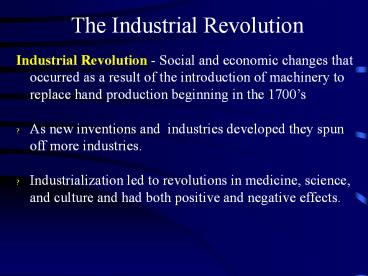The Industrial Revolution - PowerPoint PPT Presentation
Title:
The Industrial Revolution
Description:
The Industrial Revolution Industrial Revolution - Social and economic changes that occurred as a result of the introduction of machinery to replace hand production ... – PowerPoint PPT presentation
Number of Views:137
Avg rating:3.0/5.0
Title: The Industrial Revolution
1
The Industrial Revolution
- Industrial Revolution - Social and economic
changes that occurred as a result of the
introduction of machinery to replace hand
production beginning in the 1700s - As new inventions and industries developed they
spun off more industries. - Industrialization led to revolutions in medicine,
science, and culture and had both positive and
negative effects.
2
- Basic characteristics of the Industrial
Revolution - Increased use of machinery into manufacturing
- Introduction of new power sources.
- Steam
- Electricity
- Oil
- Manufacturing was geared to mass production
through the use of - Interchangeable parts
- Specialization
- Assembly lines
- Production moves from home (cottage) to factories
- Dramatic growth in capitalism and corporations
- Spread of industrialization from Great Britain to
other parts of the Europe and world.
3
Basic Causes of the Industrial Revolution
- The Commercial Revolution
- An economic revolution in Europe between
1500-1750 as a result of exploration and
colonization. The wealth helped finance the
Industrial Revolution - The Scientific and Intellectual Revolutions
- Social Revolutions of the 16th and 17th
centuries that created an atmosphere of invention
and experimentation - The Agricultural Revolution
- Changes in agriculture that led to greater food
production and increased population. This created
a large labor pool to work in factories.
4
The Enclosure Movement
- The British Parliament passed Enclosure Laws in
the late 1600s which required the fencing of
farmland. The result was - Small farmers couldnt afford fencing and were
forced to sell to wealthy farmers who
began fencing in common land. - Small farmers were forced to become tenant
farmers or move to cities in search of work. - Urban populations grew rapidly and a large labor
pool developed in the cities.
5
World Population Growth
7 billion
6.7 billion
2011
6 billion
1997
5 billion
2 billion
1994
1 billion
1987
1950
1860
6
British Population Growth
- 1770
- London 770,000
- Manchester 27.200
- Liverpool 34,400
7
British Population Growth
- 1770
- London 770,000 2,400,000
- Manchester 27,200 400,000
- Liverpool 34,400 375,000
1850
8
Why Industrialization Began in England
- The necessary factors of production were
available - Land - Natural resources Coal, iron, rivers,
harbors. - Labor - Enclosure had created a large labor pool
necessary to run factories. - Capital - Commercial Revolution enriched many who
wanted to invest their wealth in
industrialization. - Management - An educated middle class provided
people to pull resources together and manage
factories. - Government - British government was stable by the
1700s and provided incentives for
industrialization.
9
Why Industrialization Began in England
- Isolation - British Isles were isolated from the
wars and revolutions that ravaged Europe in the
1700s - Markets - Because Britain had a large empire, it
had a large market for its finished goods - Large Fleet - Britain had the worlds strongest
navy and a large commercial fleet to carry its
goods abroad.
10
The Industrial Revolution Began in the Textile
Industry
- The textile industry was the first industry in
Great Britain to become mechanized. Cotton cloth
had been imported into England since the Middle
Ages. It was popular but expensive. As Britain
expanded its empire, the demand for cotton grew
rapidly. British merchants began importing raw
cotton and hired spinners and weavers to make it
into cloth. This was done in the home as part of
a domestic system. The demand, however was much
greater than supply. As a result, inventors began
looking for ways to increase production. Numerous
inventions led to increased production and a
shift away from the domestic system to a factory
system.
11
Seed Drill 1721Jethro Tull
12
Cottage Spinning
- Spinning of thread was initially done in the home
on a single spinning wheel usually by the female
of the household. - Thread would then be woven into cloth when time
allowed or sold to weavers.
13
Cottage Weaving
- Thread would be woven into cloth typically done
on a hand loom by a single weaver. - Usually the male of the household during
non-growing seasons - Finished cloth would be sold to merchants or
tailors.
14
Flying Shuttle John Kay1733
- Doubled productivity of the weaver.
- Led to greater demand for thread.
15
Spinning JennyJames Hargreaves1764
- Produced 8 times the amount of thread as the
single spinning wheel. - Temporarily met the demand for thread
16
Water FrameRichard Arkwright1769
- Water powered spinning machine
- Made thread quicker and stronger, though coarser
- Too large for home. Led to start of factory system
17
Spinning MuleSamuel Crompton1779
- Combined best features of the spinning jenny and
water frame. - Made stronger and finer thread much faster.
- Could only be located in large factories near
water. - Created oversupply of thread. Faster weaving
methods needed.
18
Power LoomEdmund Cartwright1785
- Water powered weaving machine.
- One person could weave as much as 200 hand
weavers. - Allowed cheap production of cloth which created
greater demand for cotton
19
Cotton GinEli Whitney1793
- Removed seeds from cotton.
- Could do the work of 50 people.
- Cotton production was greatly increased.
- American south became worlds cotton producing
center.































